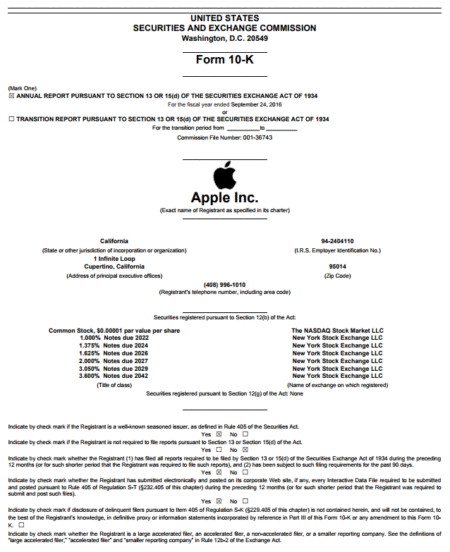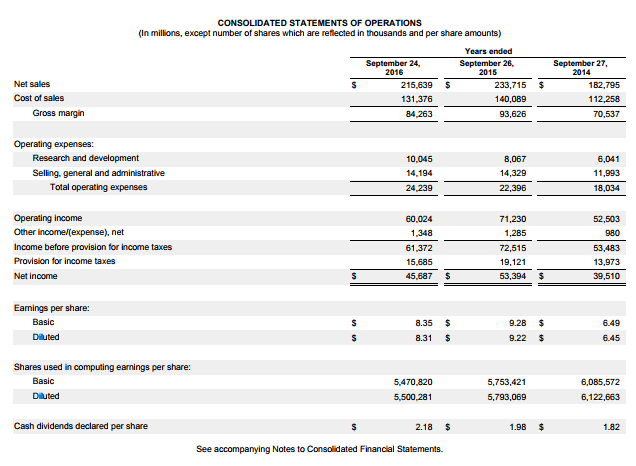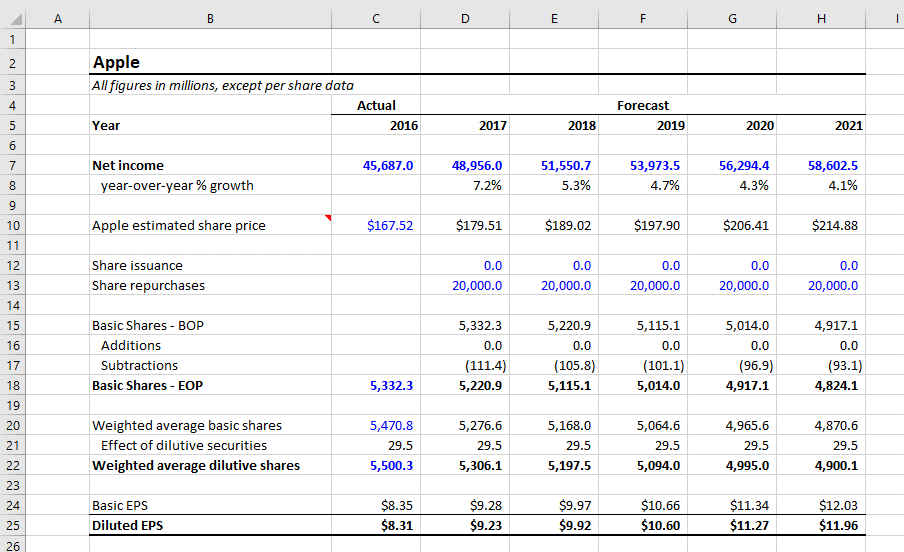How to Forecast Earnings Per Share (EPS)
One of the last steps in building a 3-statement financial model is forecasting shares outstanding. The share count matters because it tells you how much of a company is owned by each shareholder.
In the 3-statement model, this is important because it will help us forecast earnings per share (EPS), which is a ratio that shows how much of current-period net income is “owned” by each shareholder.
The logic behind this is that the more earnings, the more valuable each share becomes. The process of forecasting shares outstanding can range from simply straight-lining historical results to a more complicated analysis involving forecasts of future share repurchases and stock issuances.
Actual Shares vs. Diluted Shares: What is the Difference?
Finding the share count is fairly easy: The latest actual common share count (also called “basic shares”) can always be found on the front cover of a company’s latest 10K or 10Q. Here is Apple’s latest share count as disclosed on the front cover of its 2016 10K:

![]()
However, companies also issue diluted shares – shares that aren’t quite common stock yet but can become common stock and thus be potentially dilutive to the common shareholders (i.e. stock options, warrants, restricted stock and convertible debt and convertible preferred stock).
The Wharton Online & Wall Street Prep Applied Value Investing Certificate Program
Learn how institutional investors identify high-potential undervalued stocks. Enrollment is open for the Feb. 10 - Apr. 6 cohort.
Enroll TodayWhy Does Diluted EPS Matter More than Basic EPS?
Because it’s likely that diluted securities will eventually become common stock, analysts are usually more interested in the diluted share count than the actual share count, as they seek a more accurate picture of true economic ownership per share. An example will help to illustrate:
A company generated $100,000,000 in net income during the year and has 5,000,000 actual common shares. However, there are employees holding options on an additional 5,000,000 shares that are in-the-money and are exercisable (in other words, these employees can turn their options into common stock at any time). Basic and diluted EPS for the company is as follows:
- Basic EPS = $100,000,000 / 5,000,000 = $20.00
- Diluted EPS = $100,000,000 / 10,000,000 = $10.00
Because the option-holders can at any moment become common shareholders, the diluted share count is more indicative of the true economic ownership and claim on the earnings of the business. That’s why GAAP requires that companies report both Basic EPS and Diluted EPS on the income statement (see Apple’s 2016 income statement as an example below).

How to Forecast Shares Outstanding
There are 3 ways that analysts forecast the number of basic and diluted shares:
Approach 1 (simple): Straight line weighted average basic and diluted shares
This approach is simple. In Apple’s case above, you would simply assume basic shares of 5,470,820,000 and diluted shares of 5,500,281,000 going forward. The approach works well for companies:
- Not engaged in significant share repurchases or stock issuances
and - For which no significant difference exists between the latest basic share count (front cover of 10K) and weighted average basic share count (income statement).
This, however, doesn’t work well for Apple. Because of Apple’s share repurchase program, its latest share count (5,332,313,000 as shown on the front cover of its 2016 10K) is significantly lower than its weighted average (5,470,820,000 as shown on the 2016 income statement). Assuming Apple continues to engage in buybacks, straight-lining last year’s share count would overestimate future shares (and thus understate EPS), making this approach suboptimal.
Approach 2 (moderately simple): Straight line the latest basic shares outstanding and add the historical difference between basic and diluted weighted average shares
One problem with the first approach is that it isn’t straight-lining the latest actual share count, but rather the average during the latest period. That means that if the company’s latest share count is significantly lower or higher than the period-weighted average, the forecast will be slightly off. While the difference is usually immaterial, when there is a significant difference between latest actual share count and basic weighted average share count (as we see with Apple), analysts should employ the following process:
- Identify the latest basic share count on the front cover of the latest 10K (for annual models) or 10Q (for quarterly models) and straight-line this to forecast the future weighted average basic shares.
- Calculate the effect of diluted securities as the difference between historical basic and diluted shares, and assume this difference will persist throughout the forecast period.
- As you see on Apple’s income statement below, the difference between the basic and diluted share count can be calculated as 5,500,281,000 – 5,470,820,000 = 29,461,000.
- Add this difference to the forecast for basic shares to calculate future diluted shares.
So for Apple, we would forecast basic weighted average shares of 5,332,313,000 (as shown on front cover of its 2016 10K), and diluted weighted average shares of 5,332,313,000 + 29,461,000 = 5,361,774,000. Unfortunately, this approach still isn’t optimal for Apple, for which we continue to forecast significant future share repurchases. Every year, the share counts need to decline to reflect this.
Approach 3 (complex): Estimate new shares from issuance and repurchased shares
For companies that we expect to engage in significant buyback or share issuance activity, neither of the approaches are sufficient. Imagine that Apple is expected to repurchase $20 billion worth of Apple stock annually over the foreseeable future. Certainly, this will have the effect of lowering the actual share count, but to estimate exactly how many shares can be repurchased with $20,000,000,000, we have to predict Apple’s share count over the forecast period. We can do this by using net income growth forecasts as a proxy for share price growth. A similar process is done for calculating new shares from additional stock issuances:
Roll Forward: Basic Shares Outstanding + # of new shares issued – # of shares repurchased = Basic shares Outstanding (EOP)
| Line Item | How to Forecast |
|---|---|
| Basic Shares Outstanding | Latest actual basic share count is always disclosed on the front cover of the most recent 10K/10Q |
| # of new shares issued | Forecast the # of shares issued as $ repurchased (current period) / Estimated share price (current period)1 |
| # of shares repurchased | Forecast the # of shares repurchased as $ repurchased (current period) / Estimated share price (current period)1 |
1 Estimate the share price as prior period share price x (1+ current period consensus EPS growth rate).
Illustrative Example of EPS Forecast
In the following screenshot, you can see how this process was completed for Apple (AAPL).

EPS Forecast — Excel Template
Fill out the form below to access the Excel spreadsheet.






Hi, Definitely great article (very clear and sharp), thanks ! I’d have two questions: 1/ I take the sentence: “Certainly, this will have the effect of lowering the actual share count, but to estimate exactly how many shares can be repurchased with $20,000,000,000, we have to predict Apple’s share *count*… Read more »